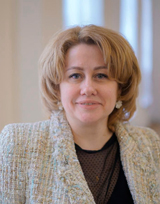The specificity of the author's image in German-language popular science texts created by authors and artificial intelligence
https://doi.org/10.18384/2949-5075-2025-4-114-127
Abstract
Aim. The purpose of the research is to identify the features of the realization of the category of the author's image as an absolute phenomenon within the framework of the German-language popular science text.
Methodology. The article compares popular science texts created by science popularizers and those created using artificial intelligence (AI). In order to identify specific features of the image of the author of a popular scientific text using general scientific research methods (analysis, synthesis, comparison, analogy), as well as methods of evaluating and processing information that involve observing linguistic and non-linguistic phenomena in their dynamics, texts of this type, published in German-language online publications on various topics in 2024–2025, were commented on.
Results. The conducted linguistic analysis showed that the image of the author is an integral category of popular science text. However, AI-generated text eliminates the emotional and evaluative component, thereby reducing the reader's level of interest and trust in the information provided, which contradicts the main purpose of popular science text.
Research implications. The theoretical significance of the work lies in expanding the methodological basis for studying polycode texts in terms of an integrated approach to analyzing the functioning of verbal and non-verbal means in the context of expressing the author’s image and in enriching the methodological tools of the German-language text. The practical significance lies in the fact that the materials of this study can be applied in scientific research on current issues of German studies and general linguistics, directly related to the linguistics of the text, as well as in the educational process for teachers of the relevant linguistic disciplines.
About the Authors
M. N. LevchenkoRussian Federation
Marina N. Levchenko (Moscow) – Dr. Sci. (Philology), Prof., Departmental Head, Department of Germanic and Romance Philology
N. I. Khristoforova
Russian Federation
Natalya I. Khristoforova (Moscow) – Cand. Sci. (Philology), Assoc. Prof., Dr. Sci. degree seeking candidate, Department of Germanic and Romance Philology; Assoc. Prof., Department I-11 “Foreign Language for Aerospace Specialties”
References
1. Anisimova, E. E. (1992). Paralinguistics and text. The problem of creolized and hybrid texts. In: Topics in the Study of Language, 1, 71–78 (in Russ.).
2. Baklanova, I. I. (2014). The image of the author and the image of the addressee of non-fiction text. Moscow: Pushkin State Russian Language Institute publ. (in Russ.).
3. Vinogradov, V. V. (1971). On the Theory of Artistic Speech. Moscow: Vysshaya shkola publ. (in Russ.)
4. Barthes, R. (1994). Selected works: Semiotics. Poetics. Moscow: Progress publ., Univers publ, (in Russ.).
5. Sapozhnikova, S. E. (2008). Scientific monograph: author – book – reader. In: Development of Personality, 2, 35b–48 (in Russ.).
6. Sukhomlina, Т. А. (2021). On the issue of typology of the author’s image in the literary texts. In: Volga Region Pedagogical Bulletin, 9 (3), 84–87 (in Russ.).
7. Bilgiler, H. A. & Kocaömer, C. (2020). Instagram in the Context of Dialogic Communication: A Content Analysis for Top Performing Brands on Instagram. In: Global Media Journal, 10 (20), 114–129.
8. Compagnon, A. (2014). Le Démon de la théorie. Littérature et sens commun. Paris: Seuil.
9. Hautli-Janisz, A., Budzynska, K., McKillop, C., Plüss, B., Gold, V. & Reed, C. (2022). Questions in argumentative dialogue. In: Journal of Pragmatics, 188, 56–79. DOI: 10.1016/j.pragma.2021.10.029.
10. Jovanovic, D. & Van Leeuwen, T. J. (2018). Multimodal Dialogue on Social Media. In: Social Semiotics, 28 (5), 683–699. DOI: 10.1080/10350330.2018.1504732.
11. Liebert, W.-A. (2019). Communicative Strategies of Popularization of Science (Including Science Exhibitions, Museums, Magazines). In: Leßmöllmann, A., Dascal, M. & Gloning, Th., eds. Science Communication. Boston, Berlin: De Gruyter Mouton, pp. 399–416. DOI: 10.1515/9783110255522-019.
12. Uspensky, B. A. (1995). Poetics of composition: The structure of the artistic text and the typology of compositional form. In: Uspensky, B. A. Semiotics of art. Moscow: Shkola «Yazyki russkoy kultury», pp. 7–218 (in Russ.).
13. Khristoforova, N. I. (2023). An Image of the Author of a Creolized Popular-Scientific Text: Possibilities of Implementation through an Internet Blog. In: Russian Linguistic Bulletin, 1 (37). URL: https://clck.ru/3PrTJH (accessed: 16.04.2025). DOI: 10.18454/RULB.2023.37.24 (in Russ.).
14. Linnik, L. A. (2020). Image of the author in the abstracts of Russian and English-language medical articles. In: Bulletin of the Bashkir University, 25 (3), 647–652. DOI: 10.33184/bulletin-bsu-2020.3.29 (in Russ.).
15. Khristoforova, N. I. (2023). Interaction of the author, the hero and the reader of a creolized internet text: on the example of German-language popular science texts. In: Modern Pedagogical Education, 6, 254–259.






























